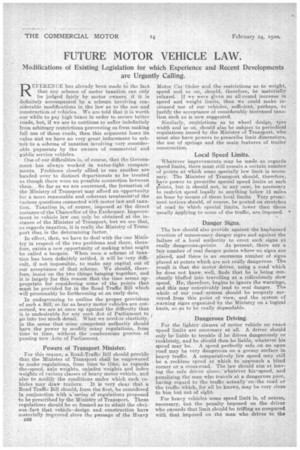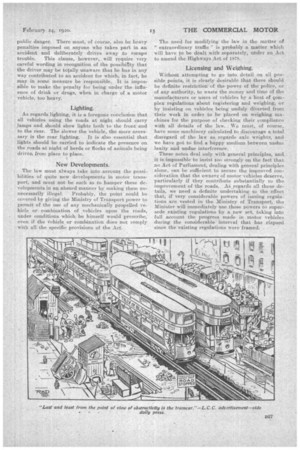FUTURE MOTOR VEHICLE LAW.
Page 14

Page 15

If you've noticed an error in this article please click here to report it so we can fix it.
Modifications of Existing Legislation for which Experience and Recent Developments are Urgently Calling.
REFERENCE has already been made tri the fact that any scheme of motor taxation can only be judged fairly by motor owners, if it is definitely accompanied by a scherne involving considerable modifications in the law as to the use and construction of Vehicles. We are told that it is worth our while to pay high taxes in order to secure better roads, but, if we are to continue to suffer indefinitely from arbitrary restrictions preventing us from making full use of those roads, then this argument loses its value and we have no very great inducement to submit to a scheme of taxation involving very considerable payments by the owners of commercial and public service vehicles.
One of our difficulties is of course, that the Governmenthas always worked in water-tight compartments. Problems closely allied to one another are handed•.over to distinct departments to be treated as though there were no possible connection between them. So far as we are concerned, the formation of the Ministry of Transport may afford an opportunity for a more reasonable and coherent treatmenteaf the various questions connected with motor law and taxation. Taxation is, of course, imposed atthe direct instance of the Chancellorof the Exchequer. improvement in vehicle law can only be obtained at the instance of the Minister of Transport, but we see that, Its regards taxation, it is really the Ministry of Tra-nsport that is the determining factor.
In effect, then, we have to deal with the one Ministry in respect of the two problems and there, therefore, exists a new opportunity of making what might be called a bargain. When once a scheme of taxation has been definitely settled, it will be very difficult, if not impossible, to make any capital out Of our acceptance of that scheme. We should, therefore, insist on the two things hanging together, and it is largely for this reason that the time seems appropriate for considering some of the points that must be provided for in the Road Traffic Bill which will presumably be forthcoming at an early date.
In endeavouring to outline the proper provisions of such aBill; so far as heavy, motor vehicles are concerned, we are at Once up against the difficulty that it is undesirable for any such Act of Parliament to go-into too-nduch detail. What.we needris elasticity, in the sense thatsome competent authority should have the power to modify many regulations, from time to time, without the "cumbersome process of passing new Acts of Parliament.
. _ Powers of Transport: Minister.
For this reason,' a Roacl,Traffie Bill should provide that the Minister, of Transport shall be empowered to makeregulations, from time totime; as regards the ispeed, axle weights, unladen weights and laden weights of various classes of heavy motor vehicle, and also to .modify the conditions -under which such vehicles may draw trailers,.It is very clear that a Road Traffic Rill should, frem the first, be considered in conjunction with a-series of regulations proposed to be prescribed by the Ministry of Transport. These regulations should be so framed as to aklinit the obvious -fact that vehicle, design and: construCtion have materially improved since the passage of the Heavy D26 Motor Car Order and the restrictions as to weight, speed a-nd so on, .should, therefore, be materially relaxed. If we were given an all-round increase in speed and weight limits, then we could make increased use of our vehicles, sufficient, perhaps, to justify the acceptance of considerably increased taxation such as is now suggested.
Similarly, restrictions as to wheel design, tyre width and so on, should also be subject to periodical regulations issued by the Minister of Transport, who must also have powers to prescribe limit dimensions, the use of springs and the main features of trailer construction,
Local Speed Limits.
Whatever improvements may be made as regards speed limits, there must. still remain a certain number of points at which some specially low limit is necessary. The Minister of Transport should, therefore, have power to prescribe special speed limits at such points, but it should not, in any ease, be necessary to restrict speed legally to anything below 12 miles an hour by means of these local limits. Very prominent notices should, of course, be posted on stretches of road to which special limits, lower than those usually -applying to some of the traffic, are imposed. • Danger Signs.
The law should also provide against the haphazard erection of unnecessary danger signs and against the failure of a local authority to erect such signs at really dangerous4points. At present, there are a fair number of real danger points where no signs are placed, and there is an enormous number of signs placed at points which are not really dangerous. The result is that the motor driver, using a road which he does not know well, finds that he is being constantly bluffed into travelling at a ridiculously slow speed. He, therefore, begins to ignore the warnings, and this may conceivably lead to real danger. The whole of our, road system should be properly surveyed from this point of view, and the system of warning signs organiied by the Ministry on a logical basis, so as to be really dependable.
Dangerous Driving.
• For the lighter classes of motor vehicle no exact speed limits are necessary at 'all. A driver should 'only, be liable to trouble if he drives dangerously or recklessly, and he should then be liable, whatever his speed may be. A speed perfectly safe on an open road may be very dangerous on a greasy surface in heavy traffic. A comparatively low speed may still be a reckless speed at which to approach a blind corner or a cross-road. The law should aim at leaving the safe driver alone, • whatever his. speed, and penalizing the man who travels at a dangerous pace, having regard to the traffic actually'on:the road or the traffic which, for all he knows, may be very close to him but out of sight.
For heavy vehicles some speed limit is, of course, necessary, but the penalty imposed on the driver who exceeds that limit should be trifling as compared with that imposed on the man who drives to the
public danger. There must, of course, also be heavy penalties imposed on anyone who takes part in an accident and deliberately drives away to escape
trouble. This clause, however, -will require very careful wording in recognition of the possibilliythat the driver may be totally unaware that he has in any way contributed to an accident for which, in fact, he may in some measure be responsible. It is impossible to make the penalty for being under the.influence of drink or drugs, when in charge of a motor vehicle, too heavy.
Lighting.
As regards lighting, it is a foregone conclusion that all vehicles using the roads at night Should carry lamps and should show lights both to the front and to the rear. The slower the vehicle, the more neces sary is the rear lighting. It is also esSential that lights should be carried to indicate the presence on the roads at night of herds or flocks of animals being driven from place to place.
New Developments.
The law must always take into account the possibilities of quite new developments in motor transport, and must not be such as to hamper these dcvelopinents in an absurd manner by making them un necessarily illegal. Probably, the point could be covered by giving the Ministry of Transport power to permit of the use of any mechanically propelled .vehicle or combination of vehicles upon the roads, under conditions which he himself would prescribe, even if the Vehicle or combination does not comply with all the specific provisions of the Act. The need for modifying the law in the matter of " extraordinary traffic " is probably a matter which will have to be dealt with separately, under an Act to -amend the HighwaysAct of 1818.
Licensing and Weighing. •
Without attempting to go into detail on all possible points, it 18 clearly desirable that there should be definite restrictionof the power of the police, or of any authority, to waste the money and time of the 'manufacturers or users of vehicles by a host of complex regulations about registering and weighing, or by insisting on vehicles being unduly diverted from .their woilt in order to be placed on weighing machines for the purpose of checking their compliance. With all details of the law. We must, of course, have some machinery calculated to discourage a total disregard of the law as. regards 'axle weights, and we have got to find a happy medium between undue laxityand undue interference.
These notes deal only with general principles, and it is impossible to insist too strongly on the fact that no Act of Parliament, dealing with general principles alone, can he sufficient to secure the improved consideration that the owners of motor 'vehicles deserve, particularly if they contribute substantially -to the improvement of the roads. As ,regards all these details, we need a definite undertaking to the effect that, if very considerable powers of issuing regulations are, vested in the Ministry of Transport, the . Minister will immediately use those powers to supersede existing regulations by a. new set, taking into full account the progress made in motor vehicles during the considerable interval that has elapsed since the existing regulations were framed.




























